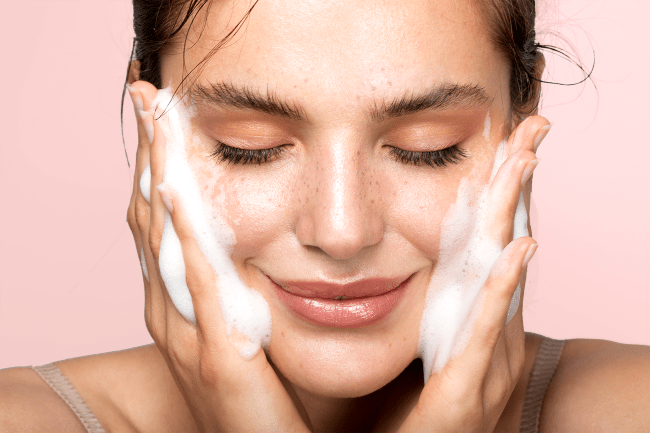Here’s How To Build The Perfect Skincare Routine

A good skincare routine helps your skin stay in good condition. As you shed skin cells throughout the day, it’s important to keep your skin glowing and in good condition. An effective routine can help prevent acne, treat wrinkles, and help your skin looking its best. It will also make you look more youthful, avoiding it from dulling and keeping it radiant. Prevention is easier than correction – preventing skin problems is easier and less costly than trying to fix them in the future.
Your skin is the largest organ in the body, and it does important things like protecting us from extreme weather, infections, and toxic substances. All skin types are different, and because of this, your skin may require more care than others. For that reason alone, a daily skincare routine is essential. Plus, having a skincare routine helps establish other healthy routines. But, how do we even know if the skincare routine that we have right now is effective?

Here’s How To Build The Perfect Skincare Routine
Whether you have a three- or nine-step routine, there’s one thing anyone can do to improve their skincare routine. Refine and enhance your skincare routine by applying products in the right order. Whatever skin concerns you may have, you’ll want to start with a clean, toned base, and finish with a moisturize – and of course, SPF in the daytime.
1 | Full-face gentle cleanse.
If you have makeup on, you can remove it with cleansing oil or micellar water. Try leaving two cotton pads on your eyes for a couple of minutes to allow the makeup to come off more easily and avoid rubbing your eyes. Morning and night – rinse your face with water and rub a small amount of gentle cleanser between clean palms.

2 | Toner.
If you use toner, apply after cleansing your face and before anything else. Pour a few drops of toner into your palms or a cotton pad and gently, swipe it onto your face. If your toner is exfoliating, you should only use it at night. Exfoliating toner removes dead skin cells with ingredients like glycolic acid. Hydrating formulas, on the other hand, can be used twice a day. However, do not use exfoliating toner and retinoids or other exfoliators at the same time.

3 | Serum.
Mornings are a great time to use a serum with antioxidants – like a brightening vitamin C serum. This allows to protect your skin from free radicals that you will encounter throughout the day. Nighttime, on the other hand, is a good time to use a moisturizing serum with hyaluronic acid. This, then, keeps your skin from drying out at night.
Moisturizing serums interact with anti-aging or acne treatments that can irritate and dry out the skin. Serums can also contain exfoliants such as alpha-hydroxy acids (AHA) or lactic acid. Whatever kind of serum you’re using or about to use, water-based ones should go underneath moisturizer. Oil-based serums, on the other hand, should be applied after moisturizer.

4 | Eye cream.
Sure, you can apply regular moisturizer to your under-eye area. However, if you decide to use a specialized eye cream, you will want to layer it underneath moisturizer. This is because eye creams tend to be thinner than face moisturizer. Try using an eye cream with a metal roller-ball applicator and storing it in the fridge. The coldness of the metal roller-ball counteracts puffiness in the morning.

5 | Spot treatment.
If you have a spot treatment, it would be better to use it at night when your body is in repair mode. Be careful of layering acne-fighting ingredients like benzoyl peroxide or salicylic acids with retinol. Unfortunately, sometimes, this causes irritation. So, make sure to do the most to keep your skin calm and completely hydrated.

6 | Moisturizer.
This hydrates skin and locks in all the other layers of product you applied. Look for a lightweight lotion for the morning, ideally with SPF 30 or higher. In the evening, you can use a thicker night cream. Those with dry skin, on the other hand, may want to use a cream morning and night.

7 | Retinoid.
In case you didn’t know, retinoids are vitamin A derivatives that include retinol. It reduces dark spot, breakouts, and fine lines through increasing skin-cell turnover. However, it can also be irritating, especially for sensitive skin. Before using retinoids, you must know that they break down in the sun. So, these should only be used during at nighttime. This also makes your skin extra-sensitive, so sunscreen is a must.

8 | Sunscreen.
Although this may be the last step, this should be the most important part of any skincare routines. Sunscreens protect your skin from UV rays which can prevent skin cancer and signs of aging. It doesn’t matter if any of your other products have SPF in it, you will still need to wear sunscreen. For chemical sunscreens, you’re going to have to wait for twenty minutes before going outside. This allows the sunscreen to be effective. Look for broad-spectrum SPF, as well. This means that it could protect you from both UVA and UVB radiation.

What do you think?
Angela Grace P. Baltan has been writing professionally since 2017. She doesn’t hesitate to be opinionated in analyzing movies and television series. Aside from that, she has an affinity for writing anything under the sun. As a writer, she uses her articles to advocate for feminism, gender equality, the LGBTQIA+ community, and mental health among others.










